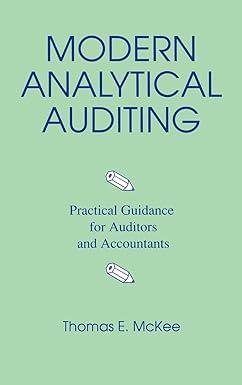Question
Many of you are familiar with the infamous story of Enron, its many internal problems, and the significance of its fall out. For the purpose
Many of you are familiar with the infamous story of Enron, its many internal problems, and the significance of its fall out. For the purpose of this discussion, we will focus on Arthur Andersen's entanglements with one of its largest clients -Enron.
Background:
Enron was created in 1985 with the merging of two natural gas companies -Houston Natural Gas and InterNorth. Enron grew quickly and expanded into new areas such as electricity and commodities. Enron received praise and accolades for its unparalleled growth -with revenues increasing more than 750% from 1996 to 2000. In fact, Enron was rated "most innovative company" for six consecutive years by Forbes magazine. However, in October 2001 the collapse of the industry giant began. At the time, Enron marked the largest corporate bankruptcy in U.S. history (until WorldCom). Employees lost $1.2 billion in retirement funds, retirees lost $2 billion in pension funds, 20,000 Enron employees lost their job, 29,000 Andersen employees lost their jobs, and it is cited as the biggest audit failure in American history.
Entanglements:
Andersen was present at the inception of the new company -providing expertise on its creation. The ties continued throughout the company's life with Andersen taking on the role of external auditor, consultant, internal auditor, and more. Alberto Gude saw it all happen in real-time from his office on the 44th floor (McRoberts). "All of a sudden your independent auditor was your internal auditor, and probably right there you had a conflict," said Gude a former Enron employee. In 1994, Andersen took over the internal auditing completely. That year, Andersen hired 40 Enron employees, including the vice president of internal audit, to be part of Andersen to perform internal audit services for Enron (Thibodeau). In just two years after taking over this critical function, Andersen's fees for this had surpassed $18 million (McRoberts). In fact, in 2000, more than half of the total fees earned by Andersen from Enron came from nonaudit services (Mayer).
David Duncan, the lead partner on the Enron engagement, developed a close relationship with Enron's Chief Accounting Officer, Richard Causey -himself an Andersen alumn. The two were cited as taking long lunches and even family vacations together (Squires). Causey was responsible for recruiting many Andersen employees to Enron -hiring at least 86 over the years. In fact, Enron made available an entire floor for dedicated office space for Andersen employees. David Duncan once remarked that he liked utilizing the available space as it "enhanced our ability to serve" and to "generate additional work" (Smith).
1.) What was the main ethical failures you found in the case Enron's Case?
2.) Were any of Dr. Marianne Jennings signs of ethical failure present in the case you selected? Which ones? Please illustrate them in detail.
Step by Step Solution
There are 3 Steps involved in it
Step: 1

Get Instant Access to Expert-Tailored Solutions
See step-by-step solutions with expert insights and AI powered tools for academic success
Step: 2

Step: 3

Ace Your Homework with AI
Get the answers you need in no time with our AI-driven, step-by-step assistance
Get Started


